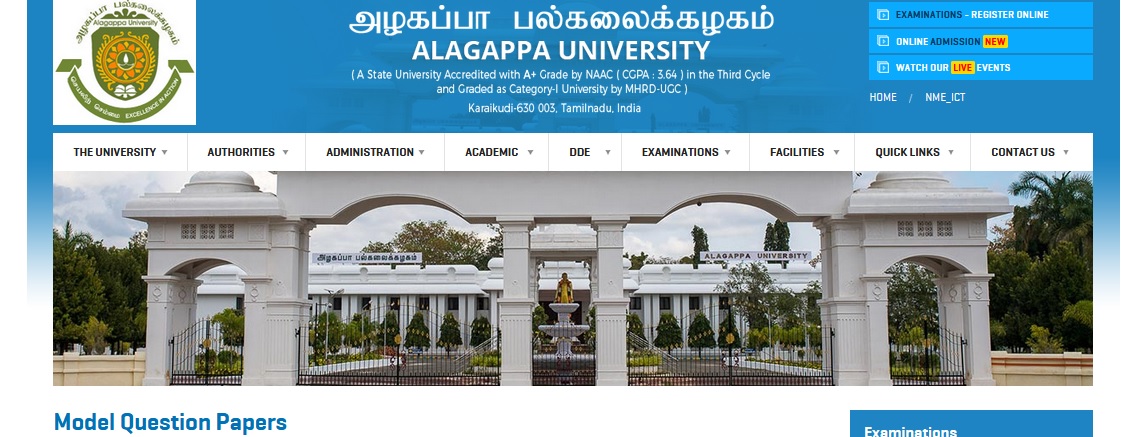Recombinant DNA Technology M.Sc Model Question Papers : alagappauniversity.ac.in
Name of the University : Alagappa University
Degree : M.Sc
Department : Biotechnology
Subject Code/Name : Recombinant DNA Technology
Document Type : Model Question Papers
Website : alagappauniversity.ac.in
Download Model/Sample Question Paper : Dec 2010 : https://www.pdfquestion.in/uploads/alagappauniversity.ac.in/4243-M.Sc.%28Biotech%29.pdf
Alagappa Recombinant DNA Technology Question Paper
M.Sc. DEGREE EXAMINATION, DECEMBER 2010
Time : 3 Hours
Maximum : 50 Marks
Related / Similar Question Paper :
Alagappa University M.Sc Biostatistics Question Paper
Section – A (10 × 1 = 10)
Answer any ten questions.
1. Explain the role of Taq DNA polymerase for Cloning.
2. Define MCS.
3. Role of S1 nuclease.
4. Define Cosmids.
5. What are the benefits of TA Cloning –
6. Name any three plant expression vectors.
7. Role of neutralization buffer during southern transfer.
8. Adapter.
9. What is forced cloning –
10. Define Touch down PCR.

11. Zoo blot.
12. What is activase –
13. Explain S1 nuclease mapping.
14. Strategies for designing of primer for PCR.
15. Explain the features of eukaryotic expression vectors.
16. Write note on chromosome walking.
17. Give brief account on clinical applications of PCR.
18. Explain the advantages of Yeast Expression Vector.
19. Describe the principles of DNA sequencing and site
20. Give detailed note on various steps involved in shot gun cloning.
21. Write an essay on the development of therapeutic
M.Sc. DEGREE EXAMINATION, DECEMBER 2010
PLANT MOLECULAR BIOLOGY
Time : 3 Hours Maximum : 50 Marks
Section – A (10 × 1 = 10)
Answer any ten questions.
1. What is TATA Box –
2. What is genome –
3. What is restorer gene –
4. What is intron –
5. What is nitrogenase –
6. What is Fe-Mo cofactor –
7. What is octopine –
8. What is crown gall –
9. What is hairy root disease –
10. What is microprojectile –
11. What is cosmid –
12. What is CaMV –
13. Enumerate plant gene structure.
14. Write notes on families of plant genes that code proteins.
15. Write notes on mitochondrial plasmids.
16. Write notes on triparental mating technique.
17. Write notes on microinjection technique.
18. Enumerate the strategy for developing virus
19. Write an essay on structure and organization of
20. Illustrate the method of gene transformation in
21. Write an essay on promoters and selectable markers
M.Sc. DEGREE EXAMINATION, DECEMBER 2010
Biotechnology
BIOINFORMATICS & IMMUNOINFORMATICS
Time : 3 Hours Maximum : 50 Marks
Section – A (10 × 1 = 10)
Answer any ten questions.
1. E3 ubiquitin ligases.
2. PepMAPPER.
3. Bit scores.
4. Motif finding
2 CP-3479
5. BioPerl.
6. Molecular clock.
7. XPlas Map 0.99.
8. Artificial gene synthesis.
9. SOLiD sequencing.
10. Structure-based (receptor).
11. MHCPred.
12. IDbases.
Section – B : (4 × 5 = 20)
Answer any four questions :
13. How do we measure sequence similarity-alignments and scoring matrices ?
14. Explain–Shotgun proteomics.
15. How will you construct phylogenetic tree through multiple sequence alignments ?
16. How will you create a map by digesting DNA with multiple restriction enzymes ?
17. Explain-High-throughput sequencing.
18. Mining genomes for vaccine components/application of in silico tools to drug development.
Section – C : (2 × 10 = 20)
Answer any two questions.
19. Describe Phosphoproteomics and Glycoproteomics with some softwares for glycotools and phosphotools.
20. Explain–Opportunities and challenges for target identification and lead discovery through Structural Biology and Bioinformatics.
21. Explain–Current status of human immunology through immunoinformatics.
Bioprocess Technology :
Time : 3 Hours
Maximum : 50 Marks
Section – A (10 × 1 = 10)
Answer any ten questions :
1. Define Microbial biomass.
2. Define Monod’s model for growth.
3. Differentiate between the Growth in batch and Continuous culture.
4. Define Shear stress.
5. List out the types of fermentors used for the growth of filamentous culture.
6. What are impellers ?
7. Mention the technique used for the removal of microbial cells in downstream process.
8. Define PID control system in the fermentor.
9. List out the pressure control and monitoring systems used in the fermentor.
10. Define Ultrafiltration.
11. Give the different types of batch filters.
12. Mention the role of trace elements in the culture medium.
Section – B : (4 × 5 = 20)
Answer any four questions.
13. Briefly discuss about the different phases of cell growth and its kinetics.
14. Discuss the concept of elemental balances with example using simplified biological conversion.
15. Give an account on non-mechanically agitated bioreactors.
16. Give an account on continuous sterilization and its advantages on batch sterilization.
17. Elaborate the various mechanical and chemical methods used for cell disruption in downstream process.
18. Describe the various filtration techniques used in downstream process.
Section – C : (2 × 10 = 20)
Answer any two questions.
19. Briefly discuss the structured models for growth and product formation with relevant examples.
20. Describe in detail the parameters involved in scale up and scale down process in bioreactors.
21. What are the various techniques employed in recovery of bioproducts ? Explain in brief about them.